
You know who you want to work with and you’ve built your website to reflect that, so you attract only the best clients for you. But what if your website turns away people who think their business is too small or too big, but actually could end up being a perfect client for you?
Recently, one of our clients met with a new personal tax client (low recurring fee but an ideal client for them) who commented the accounting firm’s website looked like the firm was too big to take on only tax return work.
In this scenario, the prospect actually got in touch and met with the accountant so their website served its purpose. But this made the accountant think, ‘what about all the ones who didn’t get in touch?’
If this has happened to you, ask yourself the following questions.
1. What type of work do you actually want to do?
Take a look at your current client portfolio. What work do you enjoy doing the most? What makes you happy? If you don’t want to do tax return or bookkeeping work, then you need to make it clear on your website this is something you don’t offer…either by saying so or by focusing your content on the things you do want to do, like management accounts for example.
Whilst it’s important to love the work you do, it’s also critical it’s profitable. What services do you offer which are the most profitable? You might not want to exclude profitable recurring tax return work even though it’s a lower fee.
What does your team have the skills for? If you are wanting to focus on management accounts but you have a team of amazing bookkeepers, you will need to make some changes before shifting to management accounts. You’ll either need to upskill and train your team on how to deliver management accounts, OR you’ll need to hire new team members who have the necessary skills to offer management accounts (and not only offer it but be great at it too).
What are your existing team great at? In Traction – Get a grip on your business, Gino Wickman shares you have to have the right people in the right seats. The right people are those that share your firms’ core values. Your team are in the right seats if each person is filling a position in your company which they understand, they want and have the capacity for. There’s no point offering services your team aren’t confident in. You’ll need to do one of the following if this is the case:
- Upskill your team
- Hire people who can offer the services you want
- Change your service offering
Now that you’ve thought about the work you want to do, think about the place your prospect is in.
2. What stage of their journey is the prospect in?
It’s important to not only look at the size of the prospects’ business, but also at what stage of their business journey they are in. Are they looking to grow and if so, how quickly? What other services might they need further down the road?
If they are just starting out, they might only need a tax return done right now but what might this lead to? Perhaps a bigger monthly retainer or a large one-off project. Don’t presume everyone wants to grow their business though. Some are happy with the clients and the team they have and may have other goals in mind.
As they grow, they will be needing more services and if they have built a solid relationship with you, they won’t be looking elsewhere for those services when the time comes. But it’s important they know those services exist, and that you keep reminding them (in a helpful way).
In the progression model below, you’ll see how to move from general awareness to a regular pipeline of leads by steadily building trust with your prospects.
Just like with an engagement, where you generally spend a few years dating and getting to know each other, your prospects are not ready to jump into a monthly relationship from the beginning. They need time to get to know you, see how you work, learn your values, build trust.
All prospects start out in the grey nothing zone of the progression model because they don’t know you. As you share helpful content, social media posts and videos and start connecting with people, your prospects will become aware of you. Now’s the time to start creating free things, like a download that answers questions they may have about a specific topic or a helpful resource like a checklist. At this stage, they aren’t quite ready to buy from you yet, but are starting to get to know you and build trust.
They’ll start appreciating the tips and resources you’ve been putting out there and will come to rely on you as a helpful resource. Soon they’ll be ready to buy something small from you. This could be in the form of a training session, a workshop or a product. If that goes well, they will probably be happy to commit to a larger project. Something focused on fixing a specific issue or a one time problem or perhaps some focused training.
And finally, they will be ready to commit to a retainer, the monthly services that you offer on a contract basis.
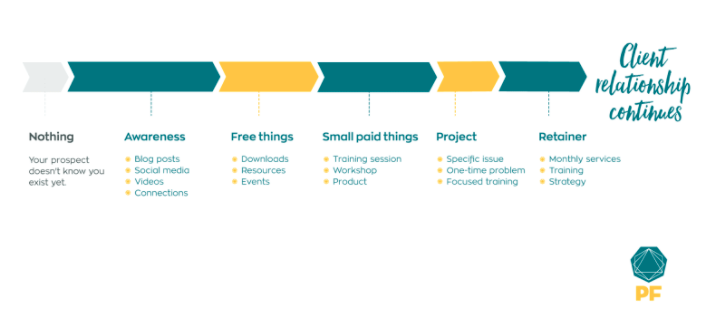
3. How can you sow the seed for future services they will need as they grow?
In order to make your clients aware of future services they will need as they grow, you’ll want to do the following:
Communicate regularly with them. It’s never too early to start discussing what their future could look like. Talk with them about their concerns and the feelings they might experience as they grow. The conversation could sound something like this: “When you start hiring, you may feel overwhelmed at the prospect of having to manage other people. This is why we need to create a business plan and look at your firm’s potential hires over the next 6-12 months so you can plan accordingly.”
By doing this, you are managing their expectations and preventing them from being surprised when you mention a new service they might need. They would already be familiar with the service, know what the cost implications are, and understand how the service will help them achieve their big picture goals.
Show them a visual representation of their potential growth over the next 12 – 24 months. People respond much better to images than they do to words because they are easier to grasp and process. We helped Accounting Lifeline create this graphic showing what a typical client journey with them might look like and what help they can offer at each stage of the journey.
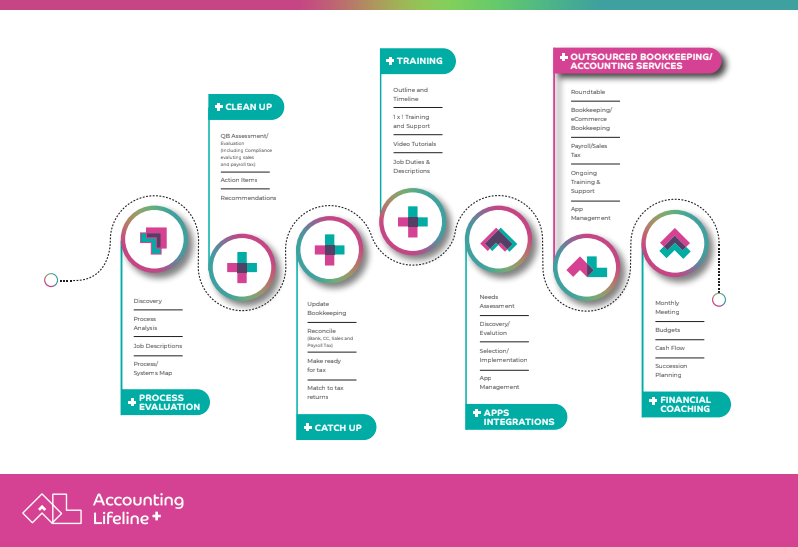
We created this graphic with Starfish showing what their clients’ typical growth journey might be. It also includes the things that Starfish can assist with along the way.
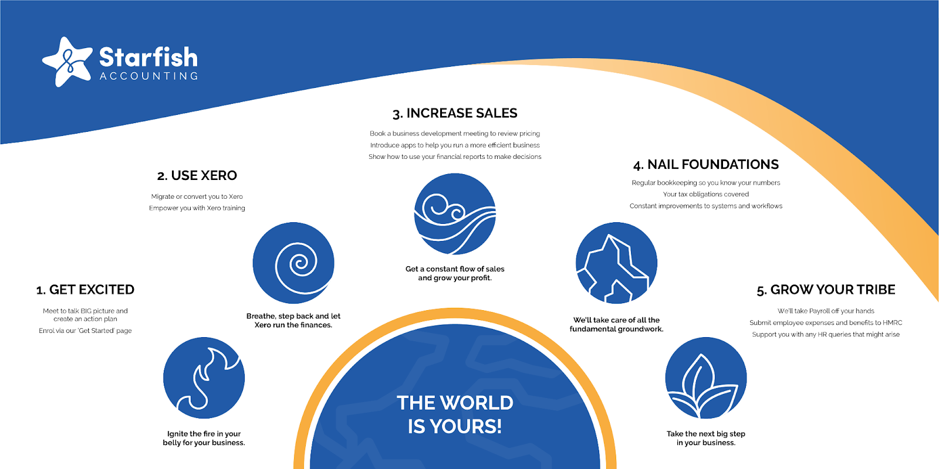
Build strong relationships. One of the best things you can do for your firm is to build strong relationships with your prospects and clients. Getting a prospect to buy from you isn’t just about selling. It’s about showing how you can help with whatever issue they are struggling with.
Educate your prospects and clients. Talk to them about the way you work, the important things to think about when it comes to their numbers and the software they will need. You don’t need to wait for someone to become a client to start educating them. Many of the issues we see happening with clients could have been prevented by sending a blog or video to the prospect to educate them about a particular area in advance of the issue occurring.
Stubbs Parkin has a page on their site that shows their prospects and clients how they work with the Ideal System. This is visible to everyone visiting their site so even their prospects are familiar with the process when they start working together.
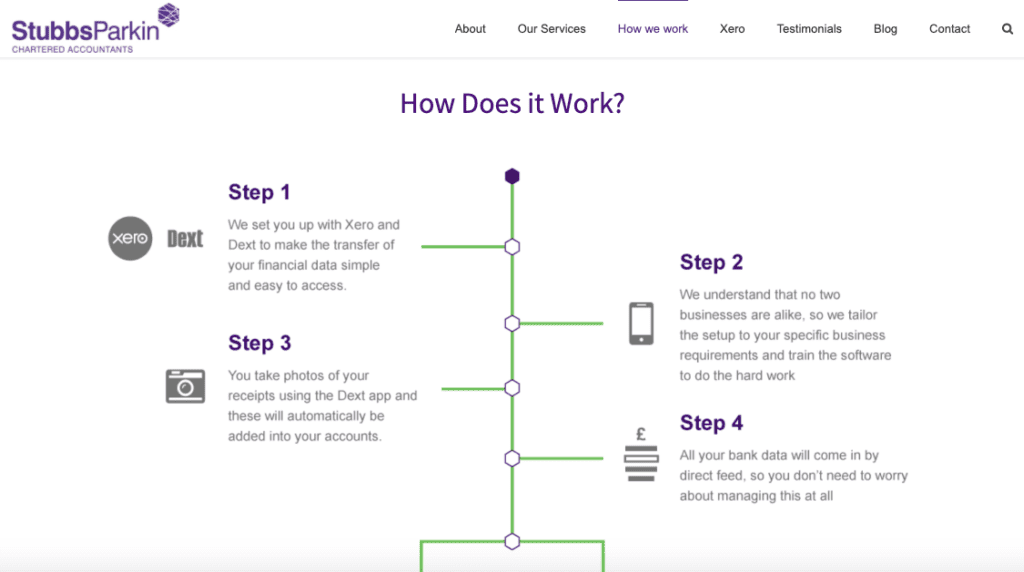
Once your prospects become clients, onboarding is the perfect opportunity to continue educating. Raedan has an onboarding page that shows how they work with their clients and what is expected from both sides.
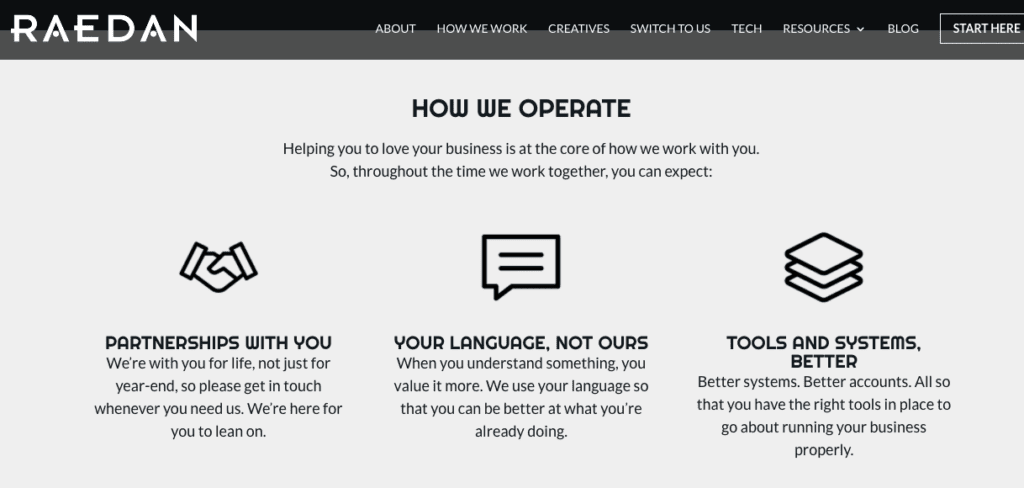
You can do the same in the form of a landing page on your website, a welcome pack guide (PDF), a series of emails, or a combination of them all.
Give away information, charge for implementation. Offer them free things like resources – templates, checklists, and guides offering solutions to problems they might have with their finances, their systems, or their way. And then offer a one-off strategy, training or support session at a small fee, without requiring them to sign up monthly yet.
4. Are you trying to be all things to all people, and finding it hard to say no?
We know how much you care about your clients and the work you do. This makes you great at your job but it can also be your downfall. You might be trying to please everyone and perhaps aren’t willing to say no (whilst being almost envious of those who do say no and focus on their audience specifically.) Sound familiar?
One of our accelerator members had their one to one session recently to discuss their audience. He said he was nervous to focus on one audience because it may turn others away. However, when he looked at the business owners or businesses he admired the most, those he saw to be the most profitable and efficient and focused, he realised they were those who said no a lot. They knew their audience and said no to everyone else.
“People think focus means saying yes to the thing you’ve got to focus on. But that’s not what it means at all. It means saying no to the hundred other good ideas that there are. You have to pick carefully. I’m actually as proud of the things we haven’t done as the things I have done. Innovation is saying no to 1,000 things.”
– Steve Jobs, WWDC 1997
If you are trying to be all things to all people, you’ll end up causing confusion – to your team, your clients and to your prospects. When you started out, you probably took any and all business that came your way. We all did.
But here’s something you may have forgotten. You are allowed to choose who you work with. Indeed, you must. It’s your business, and the more clearly you define who you want to work with (and who you work with best), the better your business will be.
Good marketing divides. It draws in the best clients for you and your firm and sends everyone else away.
Once you know your target audience, you know who you are speaking to so you know the kinds of words and phrases to use. You understand the problems your target audience are struggling with and you know how to help. You can create processes and systems that work well for your firm and your team and form the plan that your ideal audience need to follow.
Narrow down your ideal audience and become great at serving them. And don’t worry about everyone else.
5. Did your website do what it was intended to do?
Let’s say you are aiming at attracting larger retainers with higher cost fees. If your website gives the impression you are a decent sized firm (about 10 – 25 employees and more than 100 clients), and your prospects recognise you aren’t the kind of firm who focuses on tax returns only, then your website is doing its job.
If you aren’t wanting to turn away the smaller tax returns, you could add something to your services page to say you do handle tax returns but all that would do is open you up to get lots of little tax return enquiries from many people who may not be the right fit. The right type of person will get in touch if you seem like someone they want to work with, even if you might appear too big or small.
You could even say “Accounting solutions only for dentists”, on your site and you’ll still get a few people or businesses who say, “I know you say you work only with dentists, but I really love your brand and what you do. Would you work with me?” The same goes for the size of business too. You could say “Accounting solutions for small businesses” on your site and you’ll most likely get a few enquiries from larger firms who are wanting to work with you because they like your brand and your way.
In the case of our example, the prospect presumably liked what he saw on their website in terms of who they are, their values and the way they work. Perhaps he wasn’t quite sure yet, and so he got in touch – which is what you want the right kind of prospect to do.
It’s okay if your website doesn’t answer every question a prospect has
Even if your website DOES answer every question a prospect has, they still might not read it. People skim websites so it’s okay to say the same or similar thing on multiple pages throughout your site.
The site is meant to stir up connection, stir up conversation and bring you prospects. Your website doesn’t have to please everyone.
So what if your website turns away people who think their business is too small or too big, but are actually the ideal client? The right type of client will get in touch because they will want to work with you, despite the fact you may be too big or too small or perhaps that you work with a different niche. Even though our PF site clearly states that we are a marketing agency for accountants, we still have people getting in touch because they want to work with us. Because they like our culture, our values, our team and our way. Your ideal audience will be attracted by your words, your values and the way you work.
If you know your website could be more focused on your ideal audience, or you want to define that more clearly, join the next Accelerator coaching group. In this group you’ll take a 12 week dive into how all the elements of marketing work together, and how they all come back to knowing with clarity who your ideal audience is and what their issues are. You’ll then see how to use your marketing (emails, social, video, and other areas) to show that audience how you can help them best.

